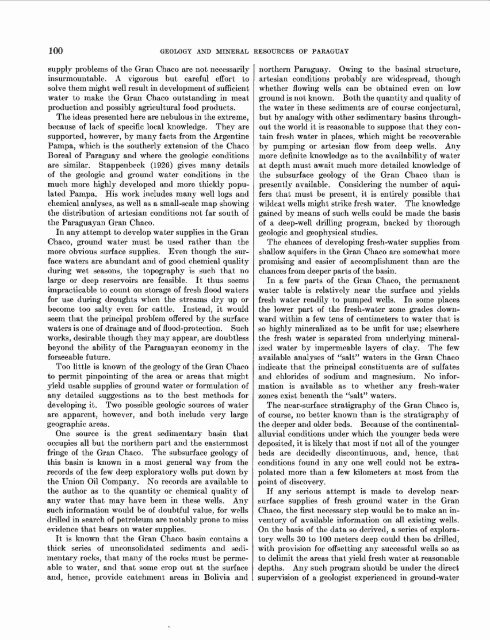Geology and Mineral Resources of Paraguay A Reconnaissance
Geology and Mineral Resources of Paraguay A Reconnaissance
Geology and Mineral Resources of Paraguay A Reconnaissance
- No tags were found...
You also want an ePaper? Increase the reach of your titles
YUMPU automatically turns print PDFs into web optimized ePapers that Google loves.
100 GEOLOGY AND MINERAL RESOURCES OF PARAGUAYsupply problems <strong>of</strong> the Gran Chaco are not necessarilyinsurmountable. A vigorous but careful effort tosolve them might well result in development <strong>of</strong> sufficientwater to make the Gran Chaco outst<strong>and</strong>ing in meatproduction <strong>and</strong> possibly agricultural food products.The ideas presented here are nebulous in the extreme,because <strong>of</strong> lack <strong>of</strong> specific local knowledge. They aresupported, however, by many facts from the ArgentinePampa, which is the southerly extension <strong>of</strong> the ChacoBoreal <strong>of</strong> <strong>Paraguay</strong> <strong>and</strong> where the geologic conditionsare similar. Stappenbeck (1926) gives many details<strong>of</strong> the geologic <strong>and</strong> ground water conditions in themuch more highly developed <strong>and</strong> more thickly populatedPampa. His work includes many well logs <strong>and</strong>chemical analyses, as well as a small-scale map showingthe distribution <strong>of</strong> artesian conditions not far south <strong>of</strong>the <strong>Paraguay</strong>an Gran Chaco.In any attempt to develop water supplies in the GranChaco, ground water must be used rather than themore obvious surface supplies. Even though the surfacewaters are abundant <strong>and</strong> <strong>of</strong> good chemical qualityduring wet seasons, the topography is such that nolarge or deep reservoirs are feasible. It thus seemsimpracticable to count on storage <strong>of</strong> fresh flood watersfor use during droughts when the streams dry up orbecome too salty even for cattle. Instead, it wouldseem that the principal problem <strong>of</strong>fered by the surfacewaters is one <strong>of</strong> drainage <strong>and</strong> <strong>of</strong> flood-protection. Suchworks, desirable though they may appear, are doubtlessbeyond the ability <strong>of</strong> the <strong>Paraguay</strong>an economy in theforseeable future.Too little is known <strong>of</strong> the geology <strong>of</strong> the Gran Chacoto permit pinpointing <strong>of</strong> the area or areas that mightyield usable supplies <strong>of</strong> ground water or formulation <strong>of</strong>any detailed suggestions as to the best methods fordeveloping it. Two possible geologic sources <strong>of</strong> waterare apparent, however, <strong>and</strong> both include very largegeographic areas.One source is the great sedimentary basin thatoccupies all but the northern part <strong>and</strong> the easternmostfringe <strong>of</strong> the Gran Chaco. The subsurface geology <strong>of</strong>this basin is known in a most general way from therecords <strong>of</strong> the few deep exploratory wells put down bythe Union Oil Company. No records are available tothe author as to the quantity or chemical quality <strong>of</strong>any water that may have been in these wells. Anysuch information would be <strong>of</strong> doubtful value, for wellsdrilled in search <strong>of</strong> petroleum are notably prone to missevidence that bears on water supplies.It is known that the Gran Chaco basin contains athick series <strong>of</strong> unconsolidated sediments <strong>and</strong> sedimentaryrocks, that many <strong>of</strong> the rocks must be permeableto water, <strong>and</strong> that some crop out at the surface<strong>and</strong>, hence, provide catchment areas in Bolivia <strong>and</strong>northern <strong>Paraguay</strong>. Owing to the basinal structure,artesian conditions probably are widespread, thoughwhether flowing wells can be obtained even on lowground is not known. Both the quantity <strong>and</strong> quality <strong>of</strong>the water in these sediments are <strong>of</strong> course conjectural,but by analogy with other sedimentary basins throughoutthe world it is reasonable to suppose that they containfresh water in places, which might be recoverableby pumping or artesian flow from deep wells. Anymore definite knowledge as to the availability <strong>of</strong> waterat depth must await much more detailed knowledge <strong>of</strong>the subsurface geology <strong>of</strong> the Gran Chaco than ispresently available. Considering the number <strong>of</strong> aquifersthat must be present, it is entirely possible thatwildcat wells might strike fresh water. The knowledgegained by means <strong>of</strong> such wells could be made the basis<strong>of</strong> a deep-well drilling program, backed by thoroughgeologic <strong>and</strong> geophysical studies.The chances <strong>of</strong> developing fresh-water supplies fromshallow aquifers in the Gran Chaco are somewhat morepromising <strong>and</strong> easier <strong>of</strong> accomplishment than are thechances from deeper parts <strong>of</strong> the basin.In a few parts <strong>of</strong> the Gran Chaco, the permanentwater table is relatively near the surface <strong>and</strong> yieldsfresh water readily to pumped wells. In some placesthe lower part <strong>of</strong> the fresh-water zone grades downwardwithin a few tens <strong>of</strong> centimeters to water that isso highly mineralized as to be unfit for use; elsewherethe fresh water is separated from underlying mineralized water by impermeable layers <strong>of</strong> clay. The fewavailable analyses <strong>of</strong> "salt" waters in the Gran Chacoindicate that the principal constituents are <strong>of</strong> sulfates<strong>and</strong> chlorides <strong>of</strong> sodium <strong>and</strong> magnesium. No informationis available as to whether any fresh-waterzones exist beneath the "salt" waters.The near-surface stratigraphy <strong>of</strong> the Gran Chaco is,<strong>of</strong> course, no better known than is the stratigraphy <strong>of</strong>the deeper <strong>and</strong> older beds. Because <strong>of</strong> the continentalalluvialconditions under which the younger beds weredeposited, it is likely that most if not all <strong>of</strong> the youngerbeds are decidedly discontinuous, <strong>and</strong>, hence, thatconditions found in any one well could not be extrapolatedmore than a few kilometers at most from thepoint <strong>of</strong> discovery.If any serious attempt is made to develop nearsurfacesupplies <strong>of</strong> fresh ground water in the GranChaco, the first necessary step would be to make an inventory<strong>of</strong> available information on all existing wells.On the basis <strong>of</strong> the data so derived, a series <strong>of</strong> exploratorywells 30 to 100 meters deep could then be drilled,with provision for <strong>of</strong>fsetting any successful wells so asto delimit the areas that yield fresh water at reasonabledepths. Any such program should be under the directsupervision <strong>of</strong> a geologist experienced in ground-water
















